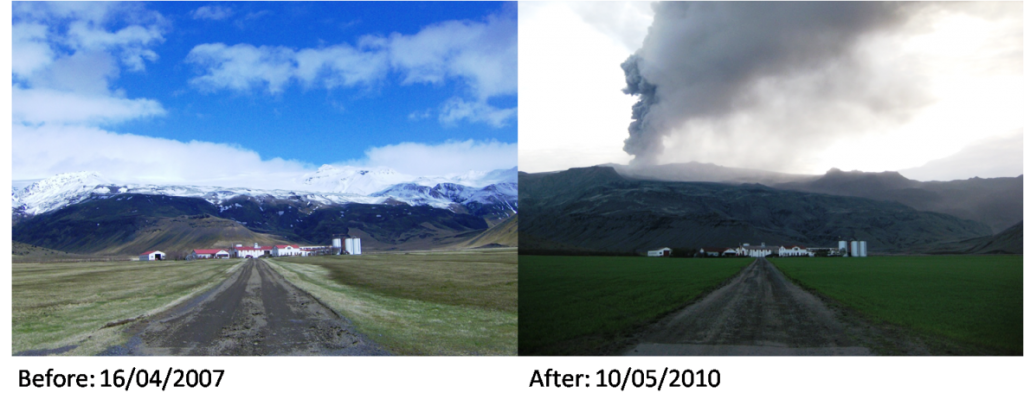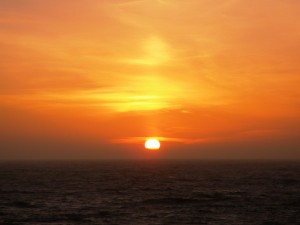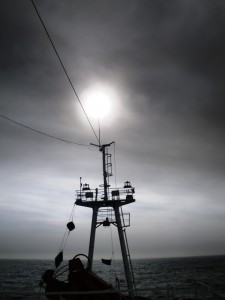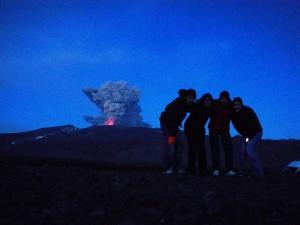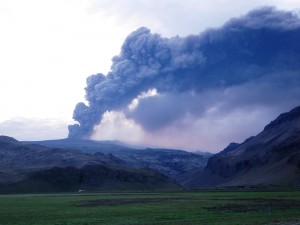A few years ago I was lucky enough to witness the infamous summit eruption of Eyjafjallajökull in 2010. Despite all the hassle it caused, especially the financial losses incurred by the aviation industry, the eruption created more awareness of the importance of volcano research in the UK. Subsequent studies of the Eyjafjallajökull eruption have advanced our understanding of many different aspects of volcanology, for example the transport and detection of ash in the atmosphere, and how recently-erupted volcanic material can affect biological productivity in the oceans. I was fortunate enough to be in the right place at the right time to contribute to some of these studies:
- Achterberg, E.P., Moore, M.C., Henson, S.A., Steigenberger, S., Stohl, A., Eckhardt. S., Cassidy, M., HemburyD., Klar, J., Lucas, M.I., Marsay, C.M., Ryan-Keogh, T.J., (2013) Natural iron fertilisation by the Eyjafjallajökull volcanic eruption. Geophysical Research Letters 40, 1–6, doi:10.1002/grl.50221
- Stevenson, J. A., C. Rae, J. S. Gilbert, S. Harangi, R. Lukács B. Højgaard, U. Árting, S. Pyne-O’Donnell, A. MacLeod, S. Loughlin, A.E. Milodowski and Cassidy, M. (2012) ‘Observations of Distal Tephra From the Eyjafjallajökull 2010 Summit Eruption’. J. Geophys. Res., doi:10.1029/2011JB008904
Below is my personal account that I wrote at the time, whilst in a creative writing mood and stuck on a ship!
—————————————————————————————————————————————————
Eyjafjallajökull: Up close and personal
(Written 12th May 2010)
“Stop the car!” I said,
“What, now?”
“Yeah – just here by the farm”
Our automatic ride pulls up at a long drive leading up to some isolated buildings in the south of Iceland. I jump out before the car comes to a standstill and the metal seat buckle breaks with a sharp crack as it gets dragged under the rental car wheel. But I’m beyond caring because (a) we’re just 4 km from the troublesome Eyjafjallajökull volcano and it’s erupting and (b) cause we rented it with my friend’s credit card.
“This is it!” I say. It was the exact same location I stood 3 years ago, whilst stopping to take a picture of a picturesque farm on a bright sunny day with glaciated hills in the background. However when I return 3 years later, the differences are clearly evident (see before and after pictures below). The weather is similar, but the atmosphere couldn’t be more different. The eruption plume is now blocking much of the sunlight, the bright red roofs of the farm are now grey with the ash, the snow capped hills have since melted and the little ice that is left has been blackened by the ash. There are loud rumblings and there is a strange metallic odour hanging in the air, as explosive pulses of molten rock are being propelled 5 km into the sky at rate of 200 tonnes per second. We can make out some of the flying lava bombs (with the naked eye) even from this distance. Then the ash starts to fall on us again. “Back in the car” we all agree, after having our fair dose of ash fall in the past few days…
We first saw the ash plume from nearly 90 km away as we sailed northwards in the Atlantic onboard the RRS Discovery. The original aim of the research cruise was to investigate Iron limitation in the IrmingerBasin (offshore west Iceland in the North Atlantic). However just two weeks before the cruise, the unpronounceable Eyjafjallajökull entered its explosive phase, sending up millions of cubic meters of ash into the atmosphere disrupting not only European airspace but also the original research plans. Debbie Hembury and myself were drafted in a week before the cruise departed from Glasgow, to trace the volcanic input to the ocean. We started our 5 week adventure feeling excited but apprehensive to say the least. After the first week full of seasickness, CTDs and plankton nets, P.I. Mark Moore decided that some scientific questions were too irresistible to ignore, so we sailed straight for the ash plume. It was time to find out if the volcanic ash input into the ocean can deliver enough essential bio-limiting elements into the ocean to have a significant effect on primary productivity. Our course was set towards the plume, and it was just warm enough to have a few bevies on the foredeck and admire a stunning volcanic sunset, made redder by the abundant acidic aerosols emitted by the volcano.
Over previous days, in our excited anticipation, we’d been scanning the horizon with squinting eyes, willing a volcanic haze to form. Suddenly there it was – directly ahead of the boat was our plume! At first it was difficult to make out, but as we drank our last sips of beer it became more defined, there was no mistaking it, snaking across the horizon in front of us. We were still 100 km away from the volcano, but we were only heading closer.
The word ‘excited’ would be an understatement for the way I was feeling the next morning as the volcano and the eruption were in clear view. Later in the afternoon, the decision was made to head even closer and to sail underneath the ash plume, some 30 km away from the volcano. My hesitation when asked if there were any risks sailing under the ash plume I’m sure didn’t settle the PI’s anxieties, but once we dug out a few precautionary face masks and suggest the asthmatics might like to stay inside – we were ready. It was eerie feeling heading under plume, which was now blocking a lot of the sunlight.
Everything changed very suddenly, firstly a few specks in the eyes- “Can you feel something?” “Umm… yeah maybe”, we say blinking slightly more than usual. Then a few minutes later it’s unmistakable, sand-sized volcanic clasts are falling out of the sky, the decks are swirling clouds of ash and you need a mask and glasses to stay outside as the ship gets inundated in black ash.
The original plan of 24 hour surveillance under the ash clouds lasts 20 minutes, as the ash starts to get inside the ship and no one can bear being outside for more than a few minutes.
We then returned to Reykjavik after the crew sprayed the ship clean again. However, there was still ash caught in every conceivable nook and cranny. Arriving late on a Sunday evening, the prospect of renting a car to get out to the volcano wasn’t looking good. With the expectation of less than a 12 hour window in port, we were in two minds whether to go or not. Our hopes were all but dashed until we tracked down a rental car company at 10 pm who had officially closed half an hour before we arrived. They let us rent an old 4×4 station wagon, we left straight away- the adventure was well and truly on! In the end the decision to rent a car to drive right up to the volcano that evening was to prove well worth it. We set off it wasn’t long before we could make out a red glow coming from the crater. After 2 hours of driving along a dirt track just north of the volcano, we got as close as it was possible to get without an off-road jeep. From this distance, just 5 km away, red jets of lava were visible flying through the air from the grumbling volcano. Iceland at this time of year never gets pitch black and so we stayed up throughout night hypnotised by the incandescence on the flanks of the volcano feeling extremely lucky to be there.
In the early hours of the morning we drove on, this time venturing along the south side visiting the odd waterfall and taking pictures till our cameras ran out of battery. We experienced heavier ash fall than on the ship, which arrived with a loud tapping noise as it rained down on the roof of the car. The effects of the eruption were more apparent in the south, where most of the ash had been deposited. We drove past blackened houses, ash covered land and roads damaged by the glacial melt floods, but all too soon it was time to return to the ship. At this point of writing the eruption has ceased, although tremors underneath the volcano continue, so it might not be the last we hear about Eyjafjallajökull – I guess we best learn how to pronounce it.
————————————————————————————————————————————————– Mike Cassidy is a post-doctoral researcher in volcanology, see his personal website for more information and you can follow him on twitter @mikevolc.
